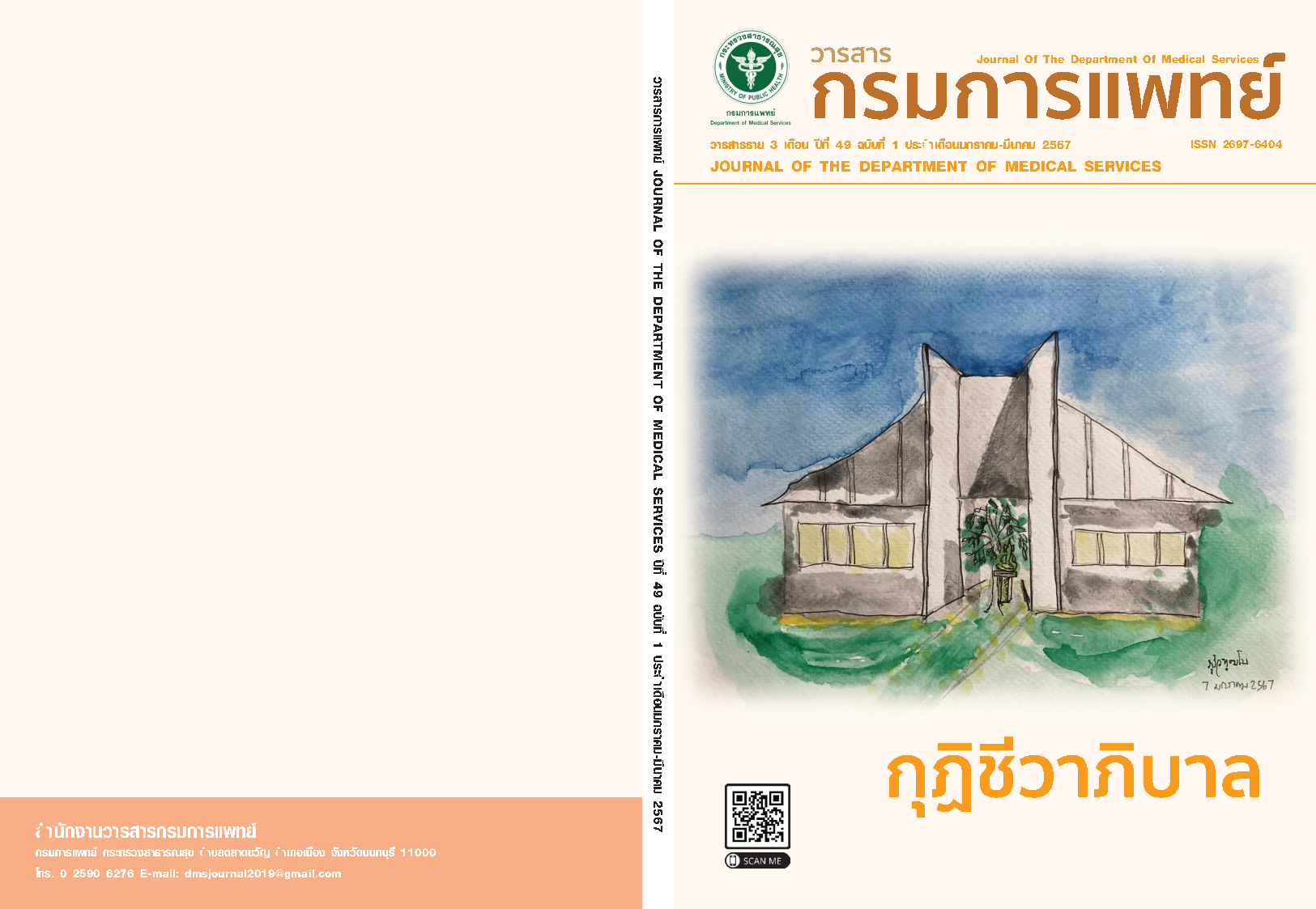The Mechanical Properties of Translucency Monolithic Zirconia vs Lithium Disilicate: A Systematic Review and Meta-analysis
Keywords:
Lithium disilicate, Mechanical properties, Monolithic zirconia, Translucency zirconiaAbstract
Background: Patients’ demand for esthetic dentistry is increasing. Translucency monolithic zirconia is developed to be the material of choice in term of esthetics besides from lithium disilicate. Objective: To synthesize research findings and a meta-analysis on the mechanical properties of translucent zirconia monolithic versus lithium disilicate materials. Methods: Systematic searching for relevant research on the PubMed, open-access and Google Scholar, as well as conducting manual searches were done. Only articles in English or Thai from 2011 to 2021 were taken. The meta-analysis of flexural strength, fracture resistance, and fracture toughness was performed from 11 accepted publications. Results: Translucency monolithic zirconia had a statistically significant higher flexural strength than lithium disilicate, but the result was inconclusive due to the lack of data homogeneity (I2=97.8%). Translucency monolithic zirconia also shown statistically significant higher fracture toughness and fracture resistance than lithium disilicate, but the result was inconclusive due to the lack of homogeneity in the data (I2=96.3%, I2=86.9%) and insufficient studies. Conclusion: Translucent monolithic zirconia is the material of choice for esthetics in high biting forces area or patients with parafunctional habits, however; further high-quality studies are required.
References
Baldissara P, Wandscher VF, Marchionatti AME, Parisi C, Monaco C, Ciocca L. Translucency of IPS e.max and cubic zirconia monolithic crowns. J Prosthet Dent 2018;120(2):269-75.
Sen N, Isler S. Microstructural, physical, and optical characterization of high-translucency zirconia ceramics. J Prosthet Dent 2020;123(5):761-8.
Pieger S, Salman A, Bidra AS. Clinical outcomes of lithium disilicate single crowns and partial fixed dental prostheses: a systematic review. J Prosthet Dent 2014;112(1):22-30.
Makhija SK, Lawson NC, Gilbert GH, Litaker MS, McClelland JA, Louis DR, et al. Dentist material selection for single-unit crowns: findings from the National Dental Practice-Based Research Network. J Dent 2016;55:40-7.
Quinn JB, Sundar V, Lloyd IK. Influence of microstructure and chemistry on the fracture toughness of dental ceramics. Dental Materials 2003;19(7):603-11.
Brizuela-Velasco A, Dieguez-Pereira M, AlvarezArenal A, Chvarri-Prado D, Solaberrieta E, FernandezGonzalez FJ, et al. Fracture resistance of monolithic high translucency zirconia implant-supported crowns. Implant Dent 2016;25(5):624-8.
Ghodsi S, Jafarian Z. A review on translucent zirconia. Eur J Prosthodont Restor Dent 2018;26(2):62-74.
Stawarczyk B, Keul C, Eichberger M, Figge D, Edelhoff D, Lumkemann N. Three generations of zirconia: from veneered to monolithic. Part I. Quintessence Int 2017;48(5):369-80.
Elsayed A, Meyer G, Wille S, Kern M. Influence of the yttrium content on the fracture strength of monolithic zirconia crowns after artificial aging. Quintessence Int 2019;50(5):344-8.
Camposilvan E, Leone R, Gremillard L, Sorrentino R, Zarone F, Ferrari M, et al. Aging resistance, mechanical properties and translucency of different yttria-stabilized zirconia ceramics for monolithic dental crown applications. Dent Mater 2018;34(6):879-90.
Kontonasaki E, Giasimakopoulos P, Rigos AE. Strength and aging resistance of monolithic zirconia: an update to current knowledge. Jpn Dent Sci Rev 2020;56(1):1-23.
Nassary Zadeh P, Lumkemann N, Sener B, Eichberger M, Stawarczyk B. Flexural strength, fracture toughness, and translucency of cubic/tetragonal zirconia materials. J Prosthet Dent 2018;120(6):948-54.
Carrabba M, Keeling AJ, Aziz A, Vichi A, Fabian Fonzar R, Wood D, et al. Translucent zirconia in the ceramic scenario for monolithic restorations: A flexural strength and translucency comparison test. J Dent 2017;60:70-6.
Nossair S, Salah T, Ebeid K. Biaxial flexural strength of different types of monolithic zirconia. Brazilian Dental Science 2019;22:Process.
Mao L, Kaizer MR, Zhao M, Guo B, Song YF, Zhang Y. Graded ultra-translucent zirconia (5Y-PSZ) for strength and functionalities. J Dent Res 2018;97(11):1222-8.
Hemdan S, abd el-aziz s, El-Sharkwy Z. Comparative study between monolithic translucent zirconia (Y-TZP) and IPS empress 2 in marginal ft and fracture strength. AlAzhar Dental Journal for Girls 2019;6(4):391-9.
Zhang F, Reveron H, Spies BC, Van Meerbeek B, Chevalier J. Trade-off between fracture resistance and translucency of zirconia and lithium-disilicate glass ceramics for monolithic restorations. Acta Biomater 2019;91:24-34.
Sterne JA, Hernan MA, Reeves BC, Savovic J, Berkman ND, Viswanathan M, et al. ROBINS-I: a tool for assessing risk of bias in non-randomised studies of interventions. BMJ 2016;355:i4919.
Fathy SM, Al-Zordk W, M EG, M VS. Flexural strength and translucency characterization of aesthetic monolithic zirconia and relevance to clinical indications: A systematic review. Dent Mater 2021;37(4):711-30.
Gibbs CH, Anusavice KJ, Young HM, Jones JS, Esquivel Upshaw JF. Maximum clenching force of patients with moderate loss of posterior tooth support: a pilot study. J Prosthet Dent 2002;88(5):498-502.
Kim HK. Optical and mechanical properties of highly translucent dental zirconia. Materials (Basel) 2020;13(15).
Kwon SJ, Lawson NC, McLaren EE, Nejat AH, Burgess JO. Comparison of the mechanical properties of translucent zirconia and lithium disilicate. J Prosthet Dent 2018;120(1):132-7.
Holz L, Macias J, Vitorino N, Fernandes AJS, Costa FM, Almeida MM. Effect of Fe2O3 doping on colour and mechanical properties of Y-TZP ceramics. Ceramics International 2018;44(15):17962-71.
Jansen JU, Lumkemann N, Sener B, Stawarczyk B. Comparison of fracture toughness measurements for zirconia materials using two test methods. Dent Mater J 2019;38(5):806-12.
Jerman E, Lumkemann N, Eichberger M, Zoller C, Nothelfer S, Kienle A, et al. Evaluation of translucency, Marten’s hardness, biaxial flexural strength and fracture toughness of 3Y-TZP, 4Y-TZP and 5Y-TZP materials. Dent Mater 2021;37(2):212-22.
Downloads
Published
How to Cite
Issue
Section
License
Copyright (c) 2024 Department of Medical Services, Ministry of Public Health

This work is licensed under a Creative Commons Attribution-NonCommercial-NoDerivatives 4.0 International License.
บทความที่ได้รับการตีพิมพ์เป็นลิขสิทธิ์ของกรมการแพทย์ กระทรวงสาธารณสุข
ข้อความและข้อคิดเห็นต่างๆ เป็นของผู้เขียนบทความ ไม่ใช่ความเห็นของกองบรรณาธิการหรือของวารสารกรมการแพทย์



